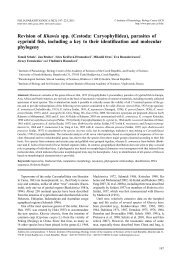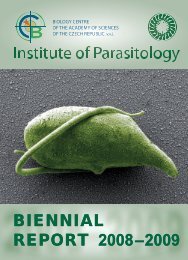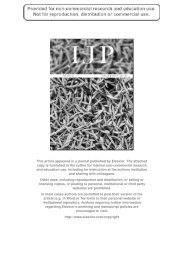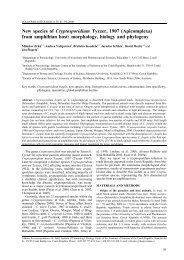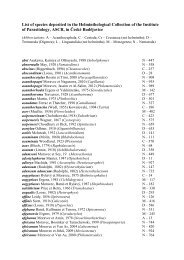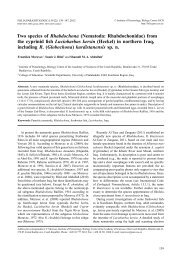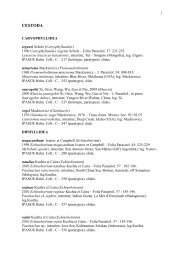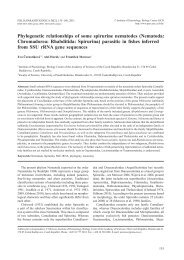Coccidia of rabbit: a review
Coccidia of rabbit: a review
Coccidia of rabbit: a review
Create successful ePaper yourself
Turn your PDF publications into a flip-book with our unique Google optimized e-Paper software.
species with “pathogenicity depending on the infective<br />
dose” (E. stiedai). This formulation means that E. stiedai<br />
exhibits, due to its localisation, some peculiarities and<br />
not that pathogenic effect in the intestinal coccidia is not<br />
dose-dependent.<br />
The pathogenicity seems to be connected, at least partially,<br />
to the localisation <strong>of</strong> the coccidia. The most pathogenic<br />
<strong>rabbit</strong> coccidia, E. intestinalis and E. flavescens,<br />
parasitize the crypts <strong>of</strong> lower part <strong>of</strong> the small intestine<br />
or caecum, respectively (Norton et al. 1979, Licois et al.<br />
1992, Pakandl et al. 2003). The intestinal epithelium is<br />
apparently more heavily damaged if the parasite destroys<br />
the stem cells located in the crypts. Gregory and Catchpole<br />
(1986) believe that destruction <strong>of</strong> crypts caused by<br />
E. flavescens is a crucial factor in the severity <strong>of</strong> the lesions.<br />
Among other species, classified by Coudert et al.<br />
(1995) as pathogenic, the endogenous development, at<br />
least the last merogony and gamogony, <strong>of</strong> E. irresidua,<br />
E. magna and E. piriformis, takes place in crypts (for citations<br />
see Tab. 1). With the exception <strong>of</strong> E. perforans,<br />
which develops both in crypts and in villi, the slightly or<br />
non pathogenic species parasitize the intestinal villi.<br />
Histopathological findings sometimes do not correlate<br />
with pathogenicity evaluated by the criteria such as<br />
mortality, weight gains and clinical signs. For example,<br />
E. coecicola causes severe lesions in the appendix (Vítovec<br />
and Pakandl 1989), but in terms <strong>of</strong> its influence on<br />
the entire organism, it is non pathogenic.<br />
3.3.3. Distribution in the mucosa<br />
Sporozoites <strong>of</strong> some <strong>rabbit</strong> coccidia migrate towards intestinal<br />
crypts and first generation meronts develop there.<br />
This was observed in E. intestinalis (Licois et al. 1992,<br />
Pakandl et al. 2006), E. piriformis (Pakandl and Jelínková<br />
2006), and E. vejdovskyi (Pakandl and Coudert 1999). In<br />
this case, the second and sometimes the following generation<br />
meronts plentifully occur in one crypt, whereas <strong>of</strong>ten<br />
no parasite stages are found in the neighbouring crypts, as<br />
the merozoites arising from the first generation probably<br />
do not migrate far and enter host cells in their proximity,<br />
giving rise to the next AG. Such an accumulation <strong>of</strong><br />
parasite stages was not observed in other coccidia, such as<br />
E. exigua, E. magna and E. media (Pakandl et al. 1996b, c,<br />
Jelínková et al. 2008), the development <strong>of</strong> which begins<br />
in upper area <strong>of</strong> the mucosa.<br />
3.4. changes In the LIfe cycLes – seLectIon for<br />
precocIousness<br />
In order to avoid continuous medication <strong>of</strong> chickens<br />
with anticoccidial drugs, different vaccination strategies<br />
have been developed. The most important in practice is<br />
currently vaccination with attenuated lines <strong>of</strong> coccidia.<br />
These lines were derived using two methods: adaptation<br />
to chicken embryos or selection for precocious development,<br />
which results in shortening <strong>of</strong> the prepatent period<br />
158<br />
Table 3. Precocious lines <strong>of</strong> <strong>rabbit</strong> coccidia.<br />
Species Shortening No.<br />
<strong>of</strong> the prepat- passages<br />
ent period needed<br />
Changes in the<br />
endogenous<br />
development<br />
Reference<br />
E. coecicola 3.5 days * * Coudert et<br />
al. 1995<br />
E. flavescens 67 hours 19 2nd (or 3rd) and Pakandl 2005<br />
4th AG are absent<br />
E. intestinalis ≤ 71 hours 6 probably the 3rd Licois et<br />
AG is absent al. 1990<br />
E. magna 46 hours 8 the last (4th) Licois et al.<br />
AG is absent 1995, Pakandl<br />
et al. 1996b<br />
E. media 36 hours 12 the last (3rd) Licois et al.<br />
AG is absent 1994, Pakandl<br />
et al. 1996c<br />
E. piriformis 24 hours 12 the last (4th) Pakandl and<br />
AG is absent Jelínková<br />
2006<br />
* no details were published; AG – asexual generation<br />
(Shirley and Long 1990). Both adaptation to embryos and<br />
precociousness are usually accompanied by the reduction<br />
<strong>of</strong> reproductive potential and pathogenicity <strong>of</strong> coccidia.<br />
The fact that the selection pressure during a relatively low<br />
number <strong>of</strong> passages leads to genetically stable changes<br />
(Jeffers 1975) is surprising. However, the genetic background<br />
<strong>of</strong> this phenomenon remains unclear.<br />
Precocious lines (PL) were selected in <strong>rabbit</strong> coccidia<br />
(Table 3). The shortening <strong>of</strong> PP is caused by the absence<br />
<strong>of</strong> one or more asexual generations and not by accelerated<br />
development <strong>of</strong> individual stages.<br />
The absence <strong>of</strong> some AG leads to reduced reproductive<br />
potential, usually 500–1,000 times. Unlike to chicken<br />
coccidia, the oocysts <strong>of</strong> precocious lines, with exception<br />
<strong>of</strong> E. flavescens, can be recognised by the oocyst morphology.<br />
Using light microscope, two refractile bodies (RB),<br />
each <strong>of</strong> them belonging to one <strong>of</strong> two sporozoites, can be<br />
seen within each sporocyst in original strains (OS). In the<br />
oocysts <strong>of</strong> the PL <strong>of</strong> E. intestinalis, two sporocysts lack<br />
RB, and two remaining sporocysts possess one huge RB<br />
(Licois et al. 1990). In PL <strong>of</strong> E. magna, E. media and E.<br />
piriformis, each sporocyst contains one large RB (Licois<br />
et al. 1994, 1995, Pakandl and Jelínková 2006). This last<br />
same feature is encountered also for E. coecicola (data not<br />
published). Electron-microscopic studies (Pakandl et al.<br />
2001) revealed that the extremely large RB can be found<br />
either inside one <strong>of</strong> the sporozoites, or free inside the sporocyst.<br />
In E. piriformis, RB, when outside the sporozoites,<br />
is included in the sporocysts residual body (Pakandl and<br />
Jelínková 2006). Sporozoites <strong>of</strong> PL <strong>of</strong> E. intestinalis,<br />
E. magna and E. media contained no, or very small, RB<br />
after in vitro excystation (Pakandl et al. 2001) and free<br />
large RB were seen inside as well as outside the sporocysts.<br />
It is unclear how the RB can leave the cell without<br />
its fatal damage and why the free RB can be conserved,<br />
as no membrane or other structure surrounding it can be<br />
observed by transmission electron microscopy. It was observed<br />
in the original strains <strong>of</strong> E. magna and E. media



